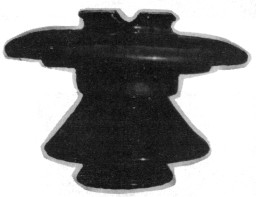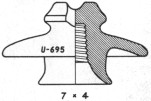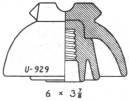Porcelain Insulator News
by Jack H. Tod, NIA #13
Reprinted from "INSULATORS - Crown Jewels of the Wire", July 1980, page 30
Dear Jack:
I've gathered from a line put up in the 20's
some large two-piece multis, very pretty, colors ranging from reddish-brown to
tan. Usually the top and bottom parts don't match in color. These are
4-7/8" - 8-1/4" - 12" by 8-1/2" high. Would you have any
idea as to their value?


Another one I'm curious about is a reddish-brown one
very much like U-695 except that the seat of the tie-wire groove is about
straight up instead of curved, and, it appears to be made with thinner porcelain
skirts.

I've traded these up to around $15 trade value, but would like your
opinion on what they should be worth.
Ben Kirsten, NIA #1991
Grand Junction,
Colo.
- - - - - - - - - -
Dear Ben:
Your items similar U-695 sound like nice items, and I'd
say your trade value is in the right ballpark, Cook Porcelain Co. was noted for
these straight-side tie-wire grooves on their larger insulators (see U-742,
U-768, U- 773, all Cook designs). However, some other companies also did the
same thing on some styles, notably Locke, and also O-B on their large multiparts
of earlier years.
Those large old multis sure are pretty things, yet I've never
had any luck selling them at any price! Every collector who runs into them in
the wilds brings them home to use as pretty driveway anchors, and I also have a
few around the edge of the patio for ornamentation. I had quite a few very
pretty Lockes just like yours and took some to shows to try to sell them for
even a few dollars each. At the third show, I finally made a fellow take one for
$1 as a penalty for asking me for a cold beer. At the fourth show, even that
would not work, and when I left, I put the last several of them on the table for
the janitor to worry about.
I really love the ones I do have, and others like
theirs too, but they aren't very much of a collector barter item. The exception
to the rule is that the very early classic multis such as the New Lexington
lilly shells and crude Fred Locke items can be worth considerable money and are
eagerly purchased by numerous collectors. If you want to ship one by U.P.S.,
make sure you have a very sturdy crate and a very fat piggy bank for the freight
tab.
Jack
Dear Jack:
... and I have an insulator identical to the U-935
Imperial (dated 7-29-99) which has a top firing rest. Does this particular
insulator have any value enhancement because of the top rest? Also, why is this
insulator made with a top rest as opposed to a normal U-935?
Adam Stoddard, NIA
#1197
Round Lake, NY
- - - - - - - - - -
Dear Adam:
I really don't think collectors make any value
distinction between specimen of same styles when the firing rest is at the top
or bottom, even if it's generally always one way and rarely the other. But we
sometimes do make special note of it, especially an these early specimens,
trying to learn more about the sequence of events back then.
But even so, the
location of the firing rest isn't a very reliable indicator of vintage etc.
Manufacturers from the 1890's to the present have used whatever firing surface
seemed less objectionable for the particular style or whichever setting surface
resulted in best stability as the insulator passed through the firing process.
Some fairly modern styles come both ways, either petticoat rest or top rest.
It's possible customer preference was involved in some of this, but I rather
imagine it was generally always a case of the factory doing their own thing in
their own way at that particular moment.
Jack

Dear Jack:
I recently attended the
collectible show in Wheaton, Ill. Had a lot of fun. I picked up a couple of rack
spools with unusual markings as I've shown with the enclosed pencil rubbings.
The Circle-L marking is stamped (incise) on a yellow-brown spool, and the
"B-J.97" is stamped (incise) around the hole of a dark brown spool. I
can't recall seeing them before, so I thought you might like to know about them.
I and another porcelain collector went through several books and couldn't locate
either.
Michael T. McLaughlin
Warsaw, Indiana
- - - - - - - - -
Dear Michael:
I was getting to be
a bit proud of having attributed nearly all the rack spool markings ever
reported to me, but you've sure loused up my batting average with these. Maybe
one of our readers recognizes one or both of them.
Jack

Dear Jack:
I
don't usually bother with porcelain insulators, but I found this big cable top,
and it has been bothering me since. I don't have any porcelain books, or I could
probably identify its shape and find the U- number. I've enclosed a drawing of
it and would appreciate any information on it, and also an estimate of its
value. The glaze is a light brown, with "turning" marks all the way
around the main body part of it.
I secured it from a dead line on a high voltage
pole in East Rutherford, NJ. It was in an old paint factory by the electric feed
line going into the plant. There are more there, plus clear glass CD-164, 214
& 252. Another company is taking the place over to use it for storage of
mopeds, so they have no use for these insulators.
The insulator has a fairly
large marking of an insulator insignia with the word "VICTOR". I
forgot, but what does the "R=oo" in this marking mean?
Ken Crawford
East Rutherford, NJ
- - - - - - - - - -
Dear Ken:
This is U-929, a glazeweld (as shown in the U-
drawing above), and it was catalogued in 1913 as the Locke #3-1/2. The particular
marking on yours was used from about 1905 up to some unknown date between there
and 1922, but the light brown glaze on yours would seem to indicate vintage more
near the 1905 end of this time span.
I have an identical insulator, same
marking, but a dark mahogany glaze, and I'd date it later than yours. Ray
Klingensmith has a U-929 with light tan glaze, but with the plain
"VICTOR" marking, and it would be earlier than yours.
The "R=oo"
in the marking (Locke's trademark of that era) is the mathematical equation of
"Resistance=Infinity" which is a classical overstatement of the Fred
Locke variety. Oddly, it was 1928 before General Electric became embarrassed
enough by this wild claim for perfection to eliminate any such reference from
their markings. To say that any insulator has infinite leakage resistance is
about like saying the moon is an infinite distance from the earth just because
it's a lot, further from the U.S. than is Berlin or Tokyo.
Yes, you'd better be
a believer that this in a goody insulator, and I'd guess the trade value of your
variety of these would be in the $15 range. It would be nice if you could rescue
the other remaining ones before they get swept away by "progress".
Regarding the combination of those clear glass items and these porcelains on the
same poles, I'd have to say "brown is beautiful" in this case!
Jack

Dear Jack:
... and it might also be of interest to other collectors that we are
using skyglaze multipart pin types with both the underglaze PP and KNOX marking
an them. The logos are stamped on the units with blue ink.
Mark A. Miner
Longmont, Colorado
Reference CJ Dec. 1978, page 21, Porcelain Products Co.
(Carey, Ohio) bought Knox Porcelain Corp. (Knoxville, Tenn.) in September 1975
and started marking all products with both the PP Co. and KNOX logos. Mark seems
to infer that the multis his crew is installing have both markings separately,
not one integral handstamp with both. I can't recall getting a report from
anyone of finding any smaller unipart insulator with the dual marking.
Jack
| 